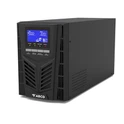1. Power capacity growth
UPS server battery are being deployed across major service providers, expanding data center capacity owned by 38 of the largest cloud and managed service providers to just under 250 million square feet by the end of 2021. Demand for electricity has expanded accordingly. In the last six months of 2021, power generation capacity of owned data center buildings grew by 1,100 megawatts to 16.1 gigawatts, enough to power 1.2 billion homes. The growth of power capacity is closely related to the growth of floor space. At the same time, telco owned DC building power capacity grew by 5% and the private business sector by 11%, with 49 new projects coming online. A series of data shows the importance of UPS server battery.

2. O&m platform for power management
Some racks require more power than others, some channels are unable to meet the electrical force data center managers want to introduce, and at other times power is available but not enough cooling capacity to keep device temperatures within manageable limits. Operators need to know if they have enough space, power and cooling to handle the load.

3. Sustainability
Business continuity depends on everything from the smallest endpoint to the largest data center, and edge deployment is considered mission critical. The need for new capabilities in software tools to maintain infrastructure resilience and security, with a focus on sustainability, is emerging as another important trend.

4. Green data center
Some nonprofits have even published reports on the energy-hungry nature of data centers. At the same time, there has been a shift away from energy sources like coal and natural gas toward renewable sources like wind and solar power. Going green has been an important move for data center and technology leaders. The whole project around green technology development is making waves in the industry.

5. Edge advantage
The power edge is another major trend. Enterprises are becoming more decentralized, with centralized data center assets and connections to hosting facilities and devices in the cloud. More recently, the demand for edge computing has also been on the rise. Therefore, you need to ensure that these edge computing resources have sufficient power. These edge deployments may require relatively modest power. Most probably only require a few kilowatts. However, when there are thousands of these edge data centers, power needs must be considered in the planning process, and this is where UPS server batteries come in.






